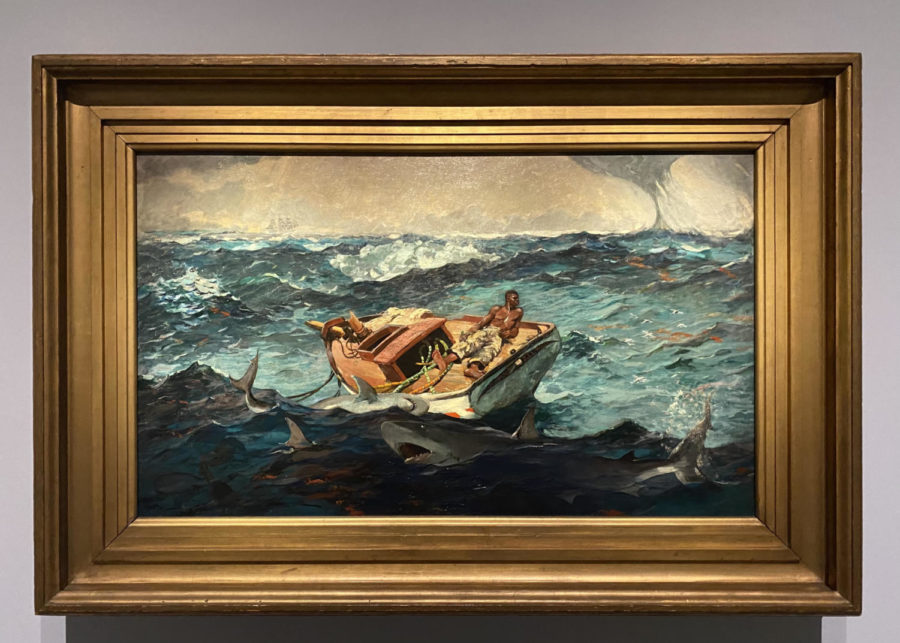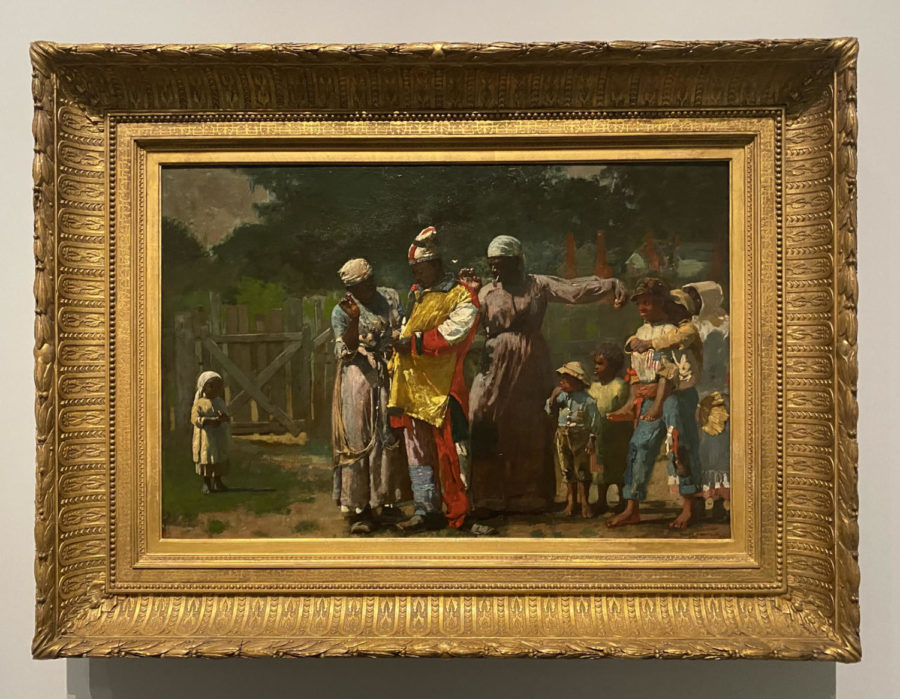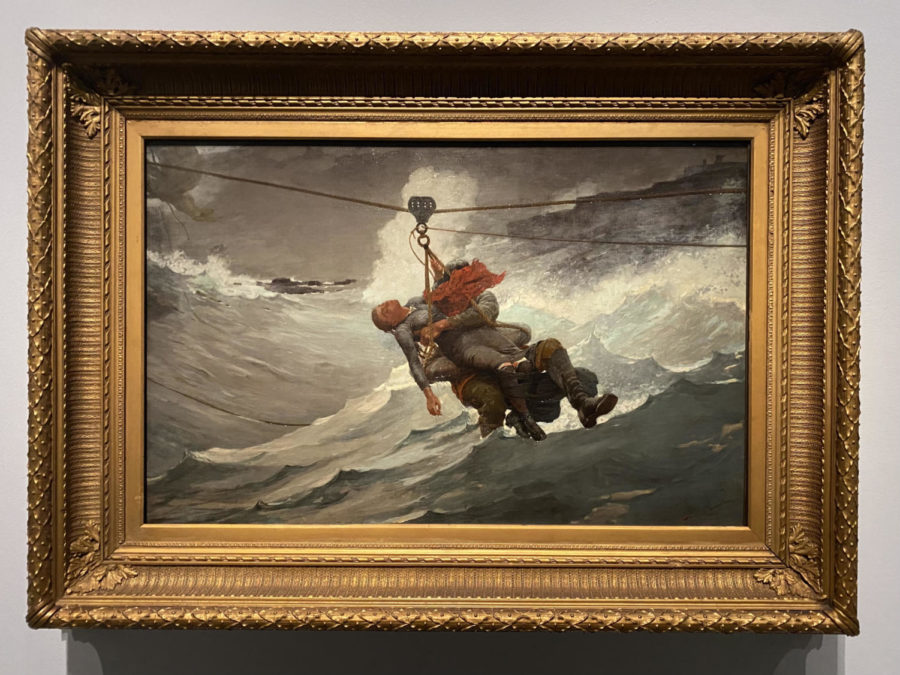Winslow Homer Crosses Creative Confinements in ‘Crosscurrents’ at the Metropolitan Museum of Art
In an era in which slavery and imperialistic agendas thrived, the American pscyhe greatly lacked social diversity. Contravening such societal conventions, Winslow Homer’s paintings functioned in the opposite fashion.
An African American is stranded amidst sharks and sugar cane, both of which represent American imperialism.
“Consider the subtleness of the sea,” said Herman Melville. Renowned for his literary genius in the novel Moby Dick, Melville remains the face of nautical storytelling. His visual arts counterpart – Winslow Homer – dismisses the prompt, instead characterizing the sea as brutish and unassailable. While humankind surrenders to its power, one does not wave the customary white flag, but one of fifty stars and thirteen stripes.
Currently, the Metropolitan Museum of Art is hosting ‘Winslow Homer: Crosscurrents’ until July 31st, 2022, in which you can view 88 of Winslow Homer’s oil paintings and watercolors, “the largest critical overview of Homer’s art and life in more than a quarter of a century.”
Homer’s American motifs are prevalent in The Gulf Stream, arguably his own Moby Dick. Amidst an omnipotent sea, an African American man casts his stoic gaze to a far off point that viewers cannot see. One is thus left to draw their own conclusions on his tentative future from the man’s somber surroundings. He lies on a shipwrecked fishing boat, its mast lost at sea. He is despondent but not distraught, perhaps merely accepting of his fate.
The boat’s only other passengers are stalks of sugarcane, in direct reference to its almost sacrosanct role in the nineteenth century economy. The crop is reminiscent of an industry sustained by slave trade through the Gulf Stream, emblematic of the man’s immobile stature.
He is encinctured by a ring of bloodthirsty sharks in the water before him, and threatened by a waterspout behind him. The former slave is not altogether hopeless; a school of flying fish are caught midair in the painting. Their ascendance from the confinements of the ocean evinces an image of freedom, indicative of what might be the man’s future.
In an effort to render his fate more subjective, Homer later added the silhouette of a sailboat in the painting’s background, after its initial completion. The Gulf Stream evokes an element of suspense: will its subject fall victim to the whims of the sea, or will fate rescue him? Homer does not answer this inquiry, leaving viewers to hypothesize on the fine line between being fettered and free.
Beyond the calculated symbolism of the black man’s surroundings, it is the manner in which Homer depicts him that renders the work politically significant. He appears muscular and humane, a generous portrayal for the Reconstruction epoch.
Though slaves were formally emancipated under President Lincoln in 1863, African American philosopher Alain Locke noted that it was not until its completion in 1899 that The Gulf Stream “began the artistic emancipation of the [African-American] subject in American art.”
Homer’s respect for the physical form of black Americans parallels his illustration of their rich culture. Dressing for the Carnival recounts a festive narrative, referencing Jonkonnu – a Christmas celebration with roots in Jamaica and West African slave ships.
Stemming from British territory in the Caribbean, Jonkunnu became hybridized with Independence Day after the Civil War, an exchange which Homer references by painting a young child clutching an American flag. The oeuvre was thus originally titled Sketch—4th of July in Virginia, an homage to its ubiquitous theme of freedom.
His reverence for such customs did not render Homer oblivious to the reality of the fundamental socioeconomic adversities which black citizens faced. Weaning the Calf juxtaposes children of different appearances: black versus white, tattered versus tidy.
The painting’s focal point is an African American boy, fighting to pull an obdurate calf away from its mother. He dons what was once a simple brown shirt and pants, but his clothing is now falling apart at the seams. Put simply, the child struggles both physically and financially.
His affluent counterparts, however, do not. Weaning the Calf depicts two white boys, observing and inert. They are clad in neatly-buttoned blouses, clean pants, and perfectly-positioned suspenders. The stark contrast of their garments and inactivity with that of the black youth gives rise to Homer’s commentary on post-war race relations. He alludes to the tension that ensued under Reconstruction through the lens of American youth.
Beyond ethnicity, rapid industrialization in the late nineteenth century catalyzed growing divides between various economic classes. “Urbanization pushed many working class families into cities where they committed their labor to factory jobs,” said Carson Michel ’23. Consequently, cities “generate[d] immense wealth for factory owners,” at the expense of the majority who were dealt paltry “wages that kept them in poverty.”
Falling victim to this design of wealth distribution is the woman at the center of Old Mill (The Morning Bell), who, despite her shared destitution, faces scrutiny from rural women. Homer paints the focal woman in a bright red dress, her presence accentuated by natural light as if the sun were smiling upon her urban lifestyle.
To the right are three women hailing from the countryside, congregated in unostentatious garb and straw hats. They are not illuminated by the sun, but rather lurk in the shadows, lingering behind the woman at the work’s fulcrum. Despite their apathy towards her – symbolic of urban-rural tension during the Industrial Era– they must follow her towards the mill, as the ringing bell atop it signals the commencement of yet another day’s work.
Inspired by his nineteenth-month voyage to England, Homer shifted his focus on working women to the grueling fishing industry. Living in Cullercoats, with an economy dependent on it, the painter’s time in the North Sea exposed him to a pervasive culture of fishing.
It was there that his artistic tenor metamorphosed, glorifying individual subjects in contrast with his previously broad, commentative narratives. Inside the Bar is a barometer for this change; within it is a fisherwoman, sporting a confident hand on her hip as she paces the beach. On each side of her is a boat, in which are solely men. Looming over them both are threatening clouds of gray, indicative of a ravaging storm to come.
The woman maintains a self-assured, almost defiant stance nevertheless, revealing her to be anything but the dainty female stereotype that plagued the American social scene. Much like many of Homer’s paintings, Inside the Bar is far from a still. It captures the fisherwoman mid-motion, her commanding stride serving as a symbolic step towards the representation of women as independent in art.
The scope of social exposition in ‘Crosscurrents’ extended internationally. Customs House, Santiago de Cuba depicts the customs house, or aduana, in which the Spanish government collected tariff revenue. Onlookers observe the scene from a ground-level view, peering up at women waving vibrant fans on the building’s balustrade.
To the left hangs the Spanish flag, tattered by battle. The flag points at the soldiers just beneath it, directing viewers’ gazes to the bayonet-armed colonial army. The painting’s militaristic motifs coincide with Homer’s observations of a war-torn Cuba– he described it as a “red hot place full of soldiers.”
Recounting the same conflict is Searchlight on Harbor Entrance, Santiago de Cuba. Entirely omitting any human presence, the painting’s focal points are a searchlight employed by the U.S. navy and a Spanish cannon. The scene in turn depicts the more modern, night light with an antiquated weapon, symbolic of the power struggle between the imperial powers.
Cuba is portrayed as almost trivial in the conflict over its own territory, a dynamic represented in emblematic detail, traditionally to Homer’s style. In the rightmost edge of the illustration, viewers may catch a mere glimpse of the Cuban coast; it is not the focal point of the Spanish-American War.
Homer later abandoned his depictions of political strife for more natural cataclysms. He stresses the relationship between humankind and its larger environment, characterizing the former as infinitely weaker than the latter. The exhibition thus neglects more classic, cathartic oceanic scenery.
The predominant theme of sea rescues arose upon the painter’s return to the United States from England, instilling within him a newfound determination to accurately represent the gravitas of his nautical observations. The Life Line strays from images of the Civil War, but it is a battle scene in its own right.
It limns a stark confrontation between humans and nature; one where the latter emerges victorious. A sailor utilizes a then newly invented breeches buoy, a system of various ropes and pulleys which aid in sea rescues. The scene was inspired by Homer’s firsthand experience in Atlantic City, New Jersey, where he witnessed such a heroic act.
Reputedly derived from the same incident is Undertow. Two women teeter on unconsciousness, their fate seeming nearly ossified. Rescuers pull them to shore, grappling with the waves’ overwhelming power over their fragility. Their waterlogged dresses cling tightly to their skin, redolent of the “wet drapery” technique in classical sculpture.
More dramatic, however, is Signal of Distress. The viewer’s perspective is one of a sailor preparing to launch a lifeboat during a ferocious storm. The crew attempts to salvage a boat in the distance, whose distressing situation is artificially amplified. Homer illustrates the mast as completely broken off and neglects to include any trace of human presence on the sinking vessel at sea.
Once northern winters become too harsh, Homer traversed this treacherous ocean to the Bahamas. It was there that he produced The Turtle Pond, in which two Caribbean men lift a sea turtle onto their boat. Characteristically of Homer’s art, the inclusion of a turtle was a deliberate, political comment. The animal was a food staple in the West Indies, rendering it a luxury for export to the United States and Britain. The turtle is thus a metaphor for empire.
A Garden in Nassau takes a stylistically different approach to a similar message. The painting’s colors are purposefully vibrant, so as to advertise tourism to the Bahamas, which its economy was dependent upon. The work is evocative of Japanese art, with many parallels to eastern depictions of nature. Below the lush flora is a black child, gazing up at a coral and limestone wall. He is excluded from the gardens before him just as Bahamians of his race were excluded from society.
“Even in the midst of destruction,” said Katia Anastas ’23, “nature has an eerie calmness about it.” Winslow Homer disagreed. He rejected Melville’s image of the sea’s “subtleness,” paving his own tumultuous yet trailblazing path through art history.
“Consider the subtleness of the sea,” said Herman Melville. Renowned for his literary genius in the novel Moby Dick, Melville remains the face of nautical storytelling. His visual arts counterpart – Winslow Homer – dismisses the prompt, instead characterizing the sea as brutish and unassailable. While humankind surrenders to its power, one does not wave the customary white flag, but one of fifty stars and thirteen stripes.
Sela Emery is a Copy Chief for 'The Science Survey.' She focuses on art history, covering relevant art pieces and exhibitions with each issue. In addition...













